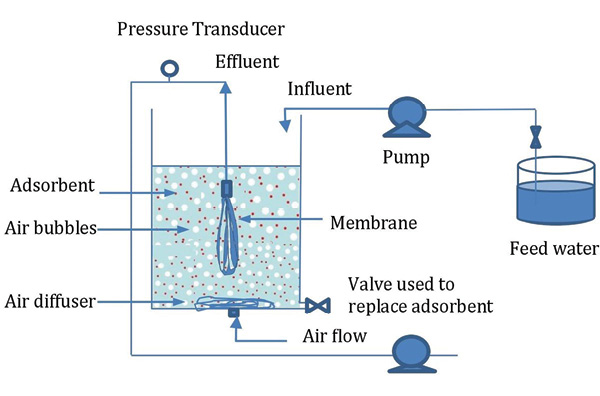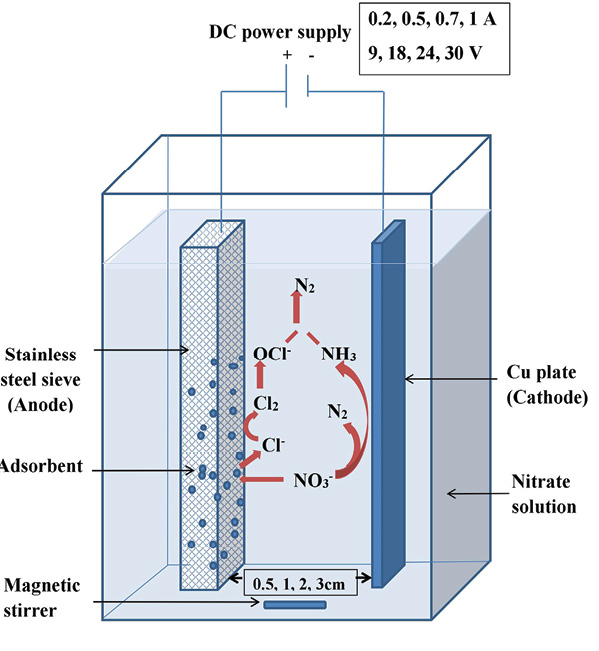Elevated nitrate concentration is a multifaceted problem. In surface water and groundwater, it can cause eutrophication. When present in drinking water, nitrate can threaten human health – for example, it can cause methemoglobinemia in infants. Thus, finding a way to remove nitrates from water is important for human and environmental health.
Adsorption technology is an attractive method to remove nitrate compared with other technologies in terms of simplicity, cost, design, operation and maintenance, and effectiveness. However, adsorbents with high capacity to selectively adsorb nitrate in the presence of coexisting anions are required to effectively remove nitrate from water. Common adsorbents used for nitrate removal do not have sufficient adsorption capacity. Although some of the commercial adsorbents have high adsorption capacity, they are expensive to use. Cost is especially an issue in developing countries, where nitrate pollution of water is a serious problem due to excessive fertiliser and manure use, and sewage leakages.
Chemical modification of surface charges
In 2013, CRC CARE funded a project that looked to develop novel adsorbents that had high nitrate adsorption capacities, and were effective in remediating nitrate-contaminated waters. An anion-exchange resin, Dowex 21K XLT, was modified by incorporating iron (Fe) on its surface (Dowex-Fe). This increased the surface positive charges. The resin was then tested for its ability to remove nitrate.1
Batch adsorption data showed that the Langmuir adsorption maximum capacity for Dowex-Fe was nearly 3 times (75 milligrams of nitrogen per gram [mg N/g]) that of the unmodified Dowex (28 mg N/g), and higher than many of the values reported in studies involving other adsorbents. The fluidised-bed adsorption capacity was also higher for Dowex-Fe. The resin was successfully regenerated by leaching the resin beds with 1 M potassium chloride (KCl) (more than 95% of nitrate was desorbed). The adsorption capacity of the resin decreased only very little after successive regenerations. The high adsorption capacity and easy regeneration of Dowex-Fe for its repeated use makes it an attractive adsorbent for removing nitrate from water.
The study included chemically modifying inexpensive agricultural wastes to increase their nitrate-adsorption capacities.2 Low-cost agricultural wastes, corn cobs and coconut copra were surface modified, but by incorporating amine groups to increase the surface positive charges. The Langmuir nitrate adsorption capacities (mg N/g) were 50 and 59 for the amine-grafted (AG) corn cob and AG coconut copra, respectively, at pH 6.5. Fixed-bed adsorption capacities were also high for these adsorbents. The adsorption capacities are higher than many of the other AG agricultural wastes and commercially available ion-exchange resins. In both batch and column experiments, nitrate adsorption decreased in the presence of sulfate, phosphate and chloride, with sulfate being the most competitive anion. More than 95% of adsorbed nitrate was desorbed by 1 M KCl in 4 adsorption/desorption cycles, and the adsorbents were successfully regenerated in each cycle with little reduction in adsorption capacity. Overall, the study showed that the modified agricultural wastes are attractive low-cost biosorbents that can be used in many countries, especially in rural areas where these wastes are produced in large amounts.
Submerged membrane (microfiltration) adsorption hybrid system
A submerged membrane (microfiltration) adsorption hybrid system (SMAHS) was also used for the continuous removal of nitrate with minimal amount of adsorbent. This system can be applied in a real-life process, similar to the column mode of removal described previously. The study showed that the volume of water treated to maintain the nitrate concentration below the World Health Organization limit of 11.3 mg N/L and the amount of nitrate adsorbed per gram of adsorbent for all 4 fluxes tested were in the order Dowex-Fe > Dowex > AG coconut copra > AG corn cob.3Increasing the flux increased the volume of water treated and the nitrate adsorbed. The benefits of the SMAHS is that the adsorbent particle size can be small, so that high-adsorption capacities are achieved.
The exhausted agricultural waste adsorbents in the column and SMAHS processes can be directly applied to land as nitrate fertilisers. The desorbed nitrate solution containing potassium can be used in fertigation to supply nitrogen and potassium to plants.

Cross-section diagram of a submerged membrane (microfiltration) adsorption hybrid system
Electrochemical method
The electrochemical method of removing pollutants in water is widely used for treating water and waste water. It is an environmentally friendly treatment technology for removing nitrate and a wide range of pollutants, with less sludge production and less use of chemicals than other treatments. In this treatment method, nitrate ions are converted to nitrogen gas (the main byproduct) and released to the environment. An electrochemical-adsorption system with a Dowex adsorbent was used to determine if it removed nitrate simultaneously using both the adsorption and electrochemical methods. The nitrate removal was found to be high and occurred quickly. This study is novel in that the electrochemical system is integrated with the adsorption process, so that the adsorbent is kept intact with the anode. This is the first time this approach has been tested. In this system, Dowex was added inside an anode stainless steel box, and a copper plate was used as the cathode. The optimum nitrate removal for the integrated system was pH 7, 1 ampere and 31 volts, with the electrodes 1 centimetre apart. Nitrate removal in the integrated system is approximately the sum of the removals from the individual processes.
The results seen in the single-cell system are encouraging. We propose to extend the single-cell system to a series of cells connected to each other for continuous nitrate removal.

Cross-section diagram of the electrochemical method of removing pollutants in water
References
- Kalaruban M, Loganathan P, Shim WG, Kandasamy J, Naidu G, Nguyen TV, et al. Removing nitrate from water using iron-modified Dowex 21K XLT ion exchange resin: batch and fluidised-bed adsorption studies. Separation and Purification Technology 2016;158:62–70.
- Kalaruban M, Loganathan P, Shim WG, Kandasamy J, Ngo HH, Vigneswaran S. Enhanced removal of nitrate from water using amine-grafted agricultural wastes. Science of the Total Environment 2016;565:503–510.
- Kalaruban M, Loganathan P, Kandasamy J, Vigneswaran S. Submerged membrane adsorption hybrid system using four adsorbents to remove nitrate from water. Environmental Science and Pollution Research 2017: doi: 10.1007/s11356-017-8905-9.